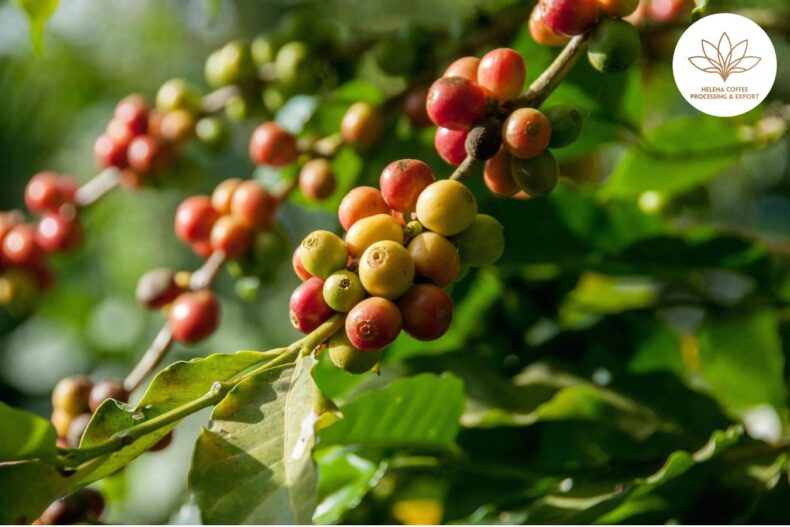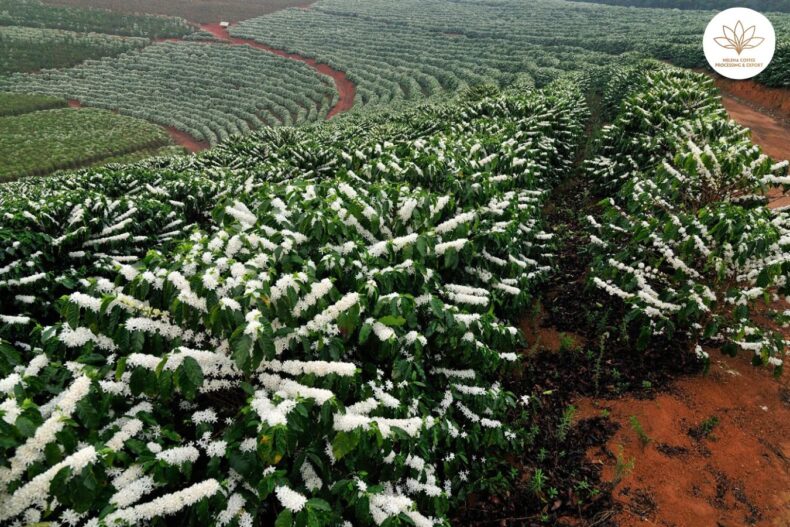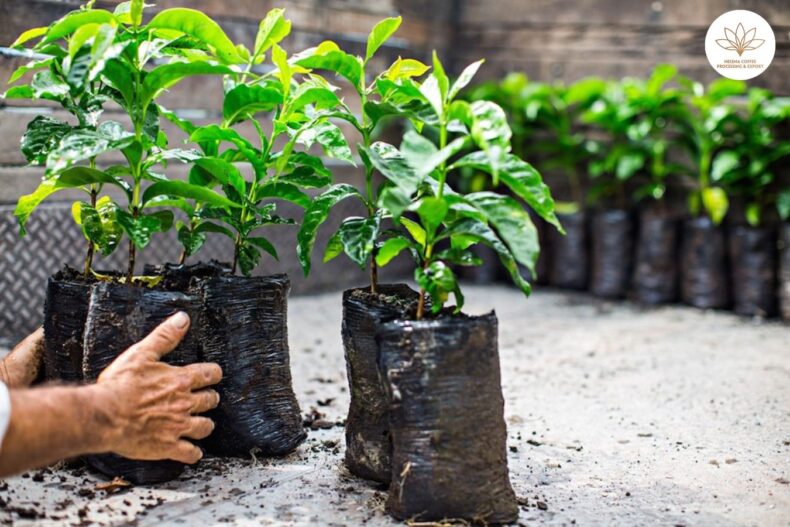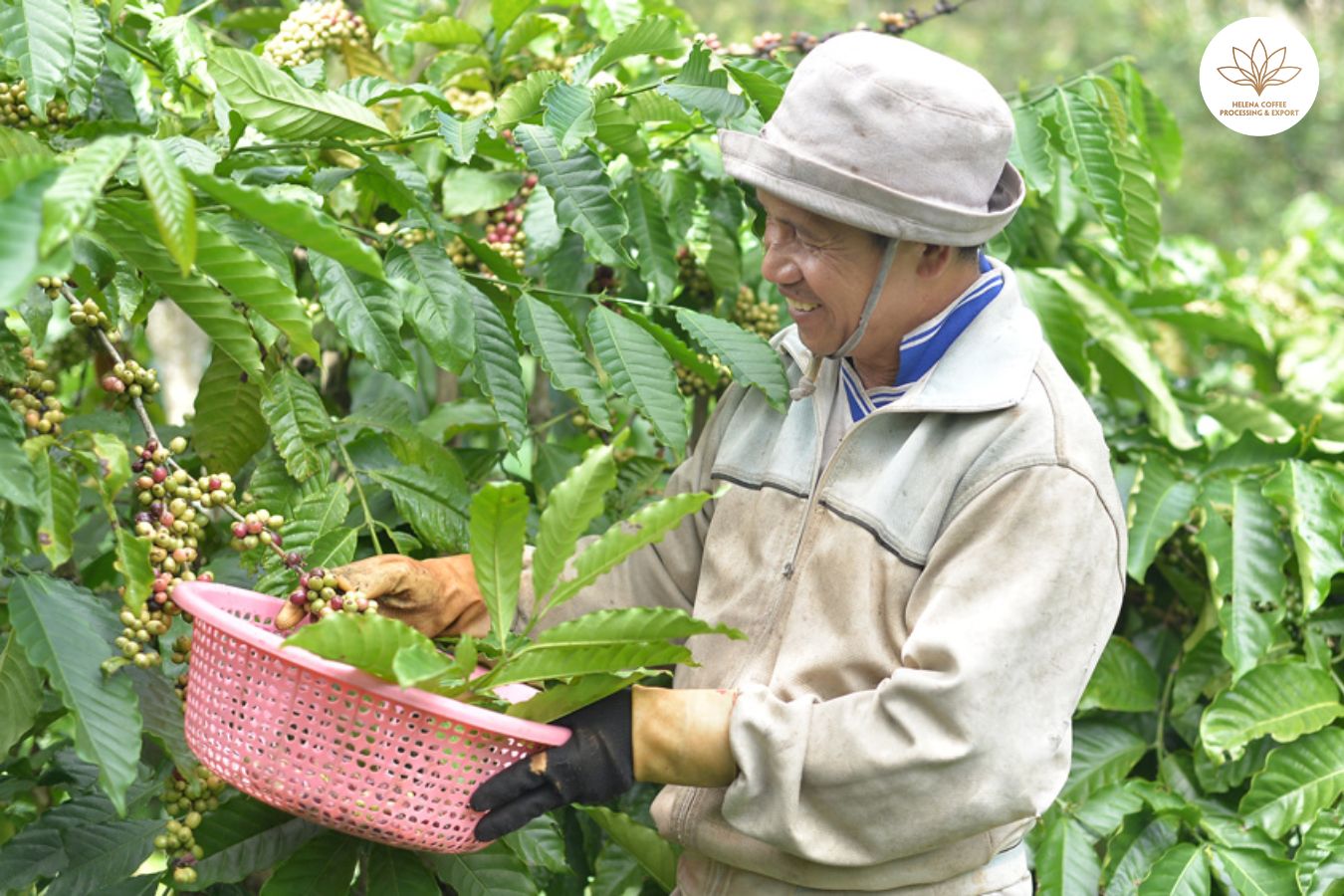
Overview of Coffee Plant Care and Growing Techniques: From selecting optimal varieties such as Arabica, Robusta and Excelsa to careful seedling care and strategic growing methods, every step is meticulously outlined, providing invaluable insights for those who Coffee growers are looking to maximize yield and quality. Through a combination of historical narrative and practical instruction, encapsulates the essence of coffee growing, celebrating its rich heritage while equipping modern farmers with the knowledge they need. needed to grow this beloved beverage.
ORIGIN
Coffee plants originate from the forests of Africa, on the Kaffa plateau of Ethiopia (at an altitude of 1370-1830 m). Since then, coffee plants were discovered by humans and migrated to other continents. In Vietnam, coffee trees were brought by French priests to grow as ornamental plants in 1857. Since 1930, coffee trees began to be grown into plantations to exploit the beans. Since then, the area, productivity, and output of coffee in our country have continuously increased.
BOTANICAL CHARACTERISTICS
Roots
Coffee plants have 3 types of roots:
- Tap roots: The roots are 0.3-0.5 m long, growing from the main stem. The main task is to use it as an axis to hold the body to avoid falling.
- Branch roots: These are branch roots growing from tap roots, penetrating deep into the soil to absorb water. Branch roots can penetrate up to 1.2 – 1.5 m deep into the ground. The deeper the branch roots, the better the ability to absorb water and withstand drought. Lateral roots grow from branch roots that develop around the root system.
- Rootlets: The development of rootlets depends on the thickness of the arable soil layer, coffee variety, fertilization, watering, and cultivation regime. This root system is mostly concentrated in the topsoil layer (From 0-30 cm). The main task is to absorb nutrients and feed the plant.
- Branches: Wooden coffee trees, if left to grow freely, can grow up to tens of meters tall. Branches growing from the main stem are called basic branches (level 1 branches), branches growing from level 1 branches are called secondary branches (level 2 branches). Under good care conditions, the basic branches of the coffee tree begin to appear 20 – 40 days after planting.
Leaves
For robusta coffee, the leaves have a lifespan of 7 – 10 months. Weather impacts or poor nutrition can cause leaves to fall earlier. Branches and leaves are closely correlated with coffee yield. Studies show that coffee leaves, branches and stems are places that store nutrients to create flowers and nourish fruit development.
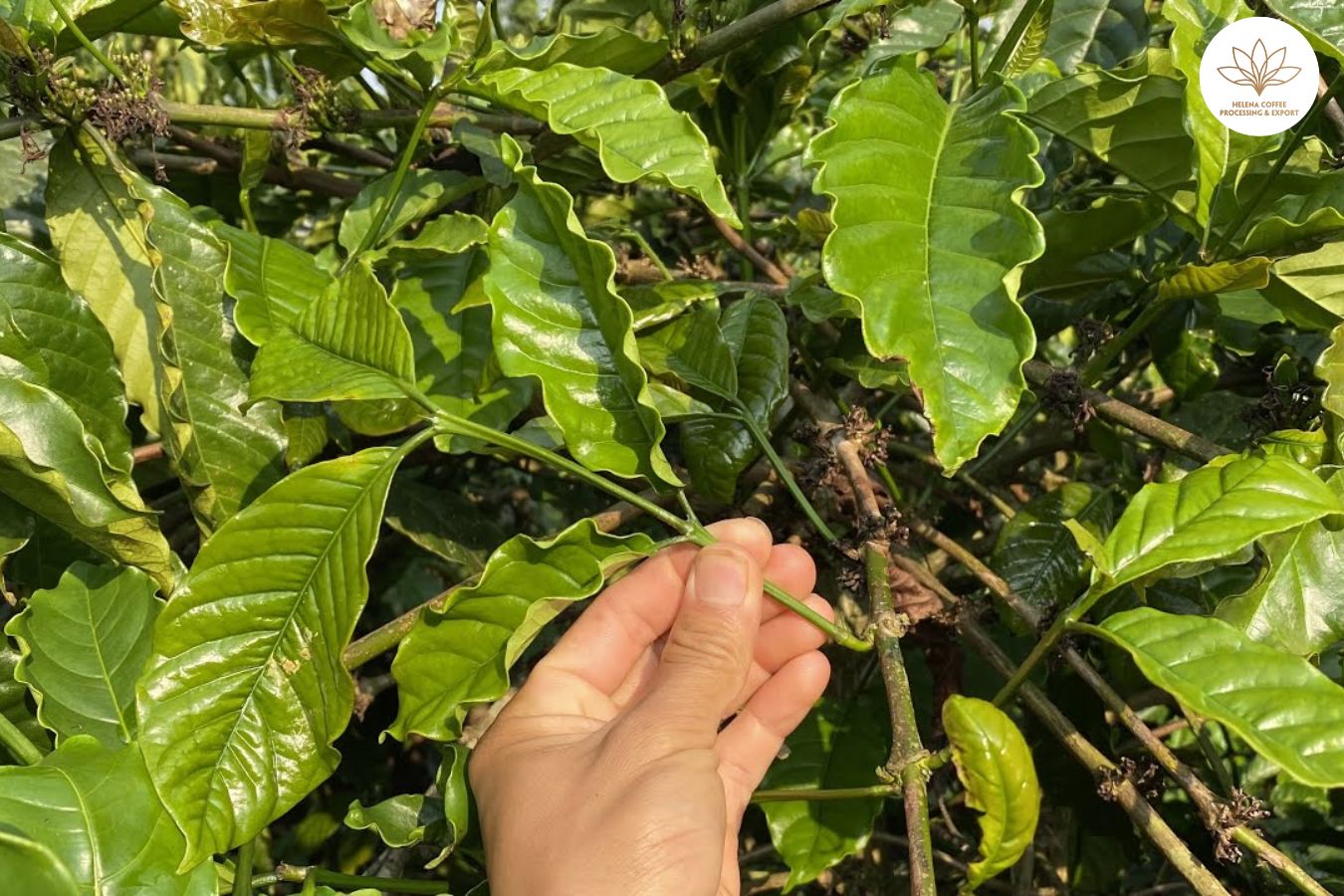
The amount of starch formed during leaf photosynthesis will be accumulated in the leaves and tissue system of the plant. If this amount decreases, it will lead to flower and fruit loss, small seeds, and low yield. This is the factor that needs attention in the process of caring for coffee trees to achieve high productivity.
Flowers
Coffee flowers grow in the leaf axils of primary and secondary branches. Coffee flowers usually bloom at night and fully bloom around 4-5 am. Robusta coffee mainly cross-pollinates, this characteristic depends a lot on wind and insects, so raising honeybees in coffee gardens is also a way to increase the rate of fruit set. of coffee. Robusta coffee does not re-flower in branches (or leaf axils) that flowered the previous year.
Fruit
After pollination, the fruit grows quickly, usually the coffee fruit has 1-2 beans (depending on the amount of watering and nutrition). The growing time for robusta coffee berries is usually 9-11 months (depending on care conditions).
EXTERNAL CONDITIONS
- Temperature: Robusta coffee plants grow best at temperatures ranging from 22 – 260 C.
- Light: Robusta coffee plants prefer weak direct light, so it is necessary to plant shade trees to regulate the light for the coffee garden properly, especially during the basic establishment stage.
- Humidity: Coffee plants are suitable for high humidity, almost saturated conditions.
- Rainfall: Coffee trees grow well in areas with annual rainfall of 1,800 – 2,000 mm, with a short dry season at the end and after harvest to differentiate flower buds.
- Wind: Hot, cold or strong winds all affect the growth and development of coffee trees. When establishing a garden, it is necessary to plant windbreak trees suitable for the coffee garden.
LAND
The coffee tree does not require strict soil requirements, it can grow well on many different types of soil such as: red brown soil, yellow brown soil or gray soil… In particular, basalt red soil coffee plants grow well and give high yields. The basic requirement is to have a topsoil layer 70 cm deep or more, with average to slightly heavy mechanical composition (light loam-clay).
VVARIETY
There are 3 main varieties:
Arabica coffee, Robusta coffee, and Excelsa coffee. Dong Nai is suitable for growing Robusta coffee.
Currently, Eakmat Institute has selected and produced many lines of coffee. Those are the lines:
- TR5 line : plants grow well, yield reaches 3.5 tons/ha. Weight of 100 kernels reaches 20.6 grams (tubers only reach 13-14 grams/100 kernels)
- TR6 line : plants grow well, are very resistant to rust, and yield 5.6 tons/ha. The weight of 100 kernels is 17.5 grams.
- TR4 line : The tree grows well, resists rust, has many branches, slightly drooping horizontal branches, and yields 7.3 tons/ha. The weight of 100 kernels is 17.1 grams.
- TR8 line : healthy growth, rust resistance, average branching, yield 4.2 tons/ha. The weight of 100 kernels is 17.6 grams.
BREEDING TECHNIQUES
Choose plants to get seeds
Choose a tree that has been bearing fruit for 6-8 years, has high and stable yield, is resistant to pests and diseases, and has a flat shape. Choose ripe fruit with two well-developed cores.
Seed treatment and sowing
Germinated seeds are sown in potting soil in a PE plastic bag (bag size 17×25cm, with 8 small holes of 0.5cm near the bottom). The soil in the pot is good, loose topsoil, with a humus content of over 3%. Clean up the layer of vegetation, trees and foreign objects on the surface, take the fertile soil layer at a depth of 10 cm into a small layer, mix well with well-rotted organic fertilizer and phosphate fertilizer.
The soil and fertilizer mixture is sieved through a 5mm sieve. The part that does not pass through the sieve is further reduced and sieved again. The gourd must be tight, balanced, vertical, leaving 0.5-1cm of the pot’s mouth to be spread with rice husk or sawdust after seeding. Before sowing seeds into pots, seeds must be treated for germination in the following order:
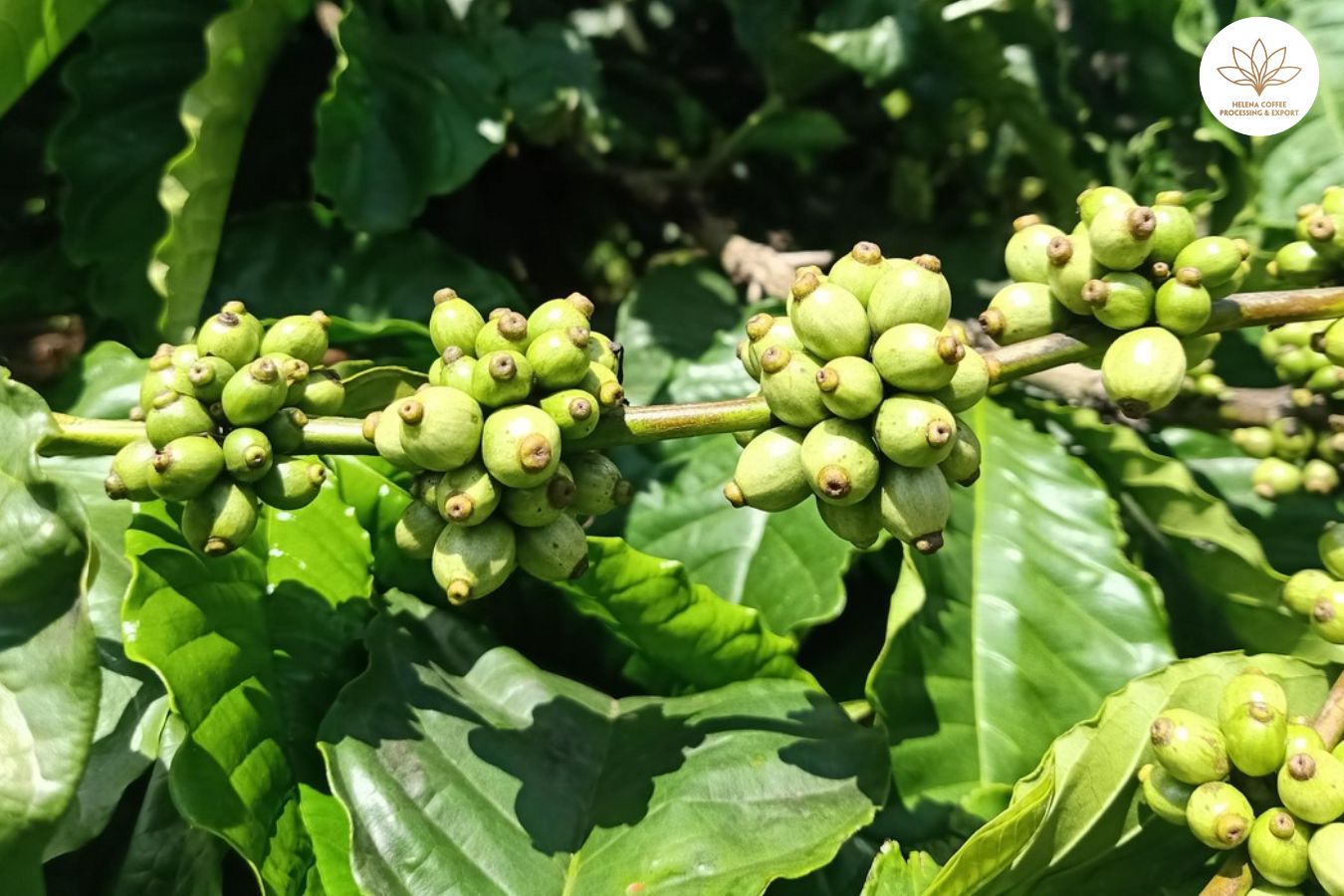
Mix lime water in the ratio of 1kg lime/50 liters of water to settle and decant the clear water, heat it to 54-600C (3 parts boiling water, 2 parts cold water) and put the seeds in to soak for 18 hours, then soak them in water. Rinse out all the slime with clean water.
Incubate seeds in a sunken bed 1-1.2m wide, 0.6-0.8m deep from the bottom of the bed with the following steps:
- Fresh green leaf stem (20-25cm)
- Unrotted manure (20-25cm)
- Thin layer of lime (0.5kg/m2)
- Layer of sack
- The seed layer in the early stages should be 10-15cm thick and watered (when the seeds begin to germinate, sprinkle them thinly from 5-8cm).
- Dry sack layer.
- Dry straw (the thicker the better).
Around the compost bed area, there is a 2m high wall, with a cover above to cover the mine during the day and cover it at night. When the plants have 2 cotyledons, pull out the seedlings, select plants with one rat’s tail root and plant them in pots prepared in the nursery.
Caring for seedlings
- Watering: Small plants water little and many times, large plants water many and few times a day.
- Fertilizer irrigation: water urea and potassium chloride solution in a ratio of 2:1 (with a concentration of 1%), alternating with soaked organic fertilizer solution (buffalo and cow manure, green manure, oil cake,…) until decomposed. rot, small plants are watered thinly, large plants are watered more heavily.
- Care: Pull out weeds, break up scum, don’t let the bulbs get flooded. In the nursery, pay attention to root rot disease and leaf yellowing disease.
- Turning the plants: the seedlings have 3-4 pairs of true leaves, turn the plants, place the large plants in the middle of the bed, and small plants on both sides of the bed to help the plants grow evenly. Note that the arrangement gradually becomes thinner as the tree grows.
* Note : remove the pergola slowly, when the tree meets the standards, it is necessary to completely remove the pergola 30 days before planting a new one.
Seedling standards
Real life tree
Before planting, seedlings grown from seeds must meet the following standards
- Tree age: 6-8 months.
- Stem height from the bulb surface: 25-35cm, stem grows straight.
- Number of real leaves: 5-7.
- Root diameter: 3-4mm
- The plants are pest-free, deformed and trained under full light for 10-15 days before planting.
- Size of potting soil: 14-15 x 24-25cm
Grafted tree
- In addition to the standards for real-life trees, grafted trees must meet
- The grafted bud is over 10cm tall and has at least 1 pair of fully developed leaves.
- Shoots are grafted at least 1 month before planting.
Grafting, renovating and upgrading the garden:
- Using buds from coffee lines with high yield, good quality, resistant to pests and diseases, grafted on bad coffee roots, has been applied and has shown good results.
CULTIVATION – CARE TECHNIQUES
Prepare the soil
The flat land is cleared of plant residue and drainage ditches are dug according to the coffee garden design diagram as follows:
- Grow robusta coffee effectively
- Coffee garden design diagram
Planting techniques
- Season: Plant at the beginning of the rainy season (May, June).
- Distance, density: Good soil and high intensive farming conditions require sparse planting and vice versa. Spacing: good and flat land 3 x 3 m (1,118 plants/ha); Average land and slope 3 x 2.5 m (1,330 trees/ha).
- How to plant: Dig a hole 1 month before planting, the hole is 60 x 60 x 60 cm. The topsoil layer is left on one side, then mixed with 10 – 20 kg of decomposed manure + 0.5 kg of super phosphate + 0.5 kg of lime powder and put into the hole. The lower layer of soil is left behind to use as a basin around the base. When planting, fertilize the outside of the tree’s foliage with 100 grams of NPK 16 – 16 – 8 – 13 S fertilizer.
FAQS:
